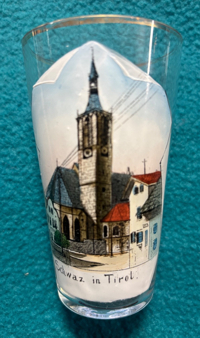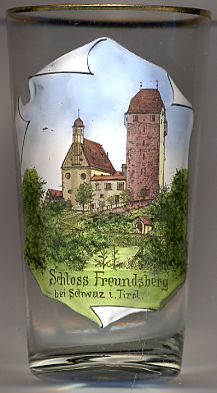

|
| ÖSTERREICH | AUSTRIA |
| Bundesland: Tirol | Tyrol |
| Bezirk: Schwaz |
 Schwaz is situated at an elevation of 545 m in the valley of the river Inn, about 40 km east of Innsbruck.
Schwaz is the administrative seat of the district of the same name. The municipality has a population of about 14.500 (2025).
Schwaz is situated at an elevation of 545 m in the valley of the river Inn, about 40 km east of Innsbruck.
Schwaz is the administrative seat of the district of the same name. The municipality has a population of about 14.500 (2025).
Archeological finds demonstrate that the area had been inhabited already in the Neolithic period (4000–2000 BC); further finds date from the Bronze age (ca.1500 BC). The earliest written document mentioning Sûates dates from AD 930. A keep was built on the hill above Schwaz around 1170. This keep was developed into Freundsberg castle in the 13th century. At first the village had a rural character, which changed into a city-like character after deposits of silver and copper were discovered. The flourishing period of silver and copper mining was the 15th and 16th century. At that time, Schwaz was the largest mining city in in Europe. At an estimated population of about 20.000 it was the second-largest town in the Habsburg countries, after Vienna. After the decline of the mining activities and the destructions of large parts of the town during the Napoleonic Wars, the town began to grow again during the 19th century. Until World War I, Schwaz was a garrison town of the Austrian Imperial Army. It was only in 1899 that the market town Schwaz was officially granted the status of a city by Emperor Franz Josef I.

The  parish church Mariä Himmelfahrt (Ascension of Our Lady) [near left]
was first mentioned in 1337. After a fire it was restored and enlarged in 1429–1432. The present church was built in 1460–1478.
Of this church the walls of the northern choir and the northern wall of the nave still exist. The next construction phase began in 1490 and lasted
until 1520.
parish church Mariä Himmelfahrt (Ascension of Our Lady) [near left]
was first mentioned in 1337. After a fire it was restored and enlarged in 1429–1432. The present church was built in 1460–1478.
Of this church the walls of the northern choir and the northern wall of the nave still exist. The next construction phase began in 1490 and lasted
until 1520.

 Freundsberg castle [near left] was founded in 1150 by the lords of Freundsberg.
The castle originally only consisted of the tower house with its five storeys. Part of its original fresco paintings are still visible today.
The castle's chapel was consecrated in 1177.In 1467 the castle was sold to Duke (1477 Archduke) Sigismund 'der Münzreiche' ('the Rich in Coin'), regent of Tyrol and Austria Anterior,
who called the castle Sigmundsruh. A new church in late Renaissance style was built next to the tower house in 1634 to 1637.
After having had several different owners in the following centuries, the castle finally came in possession of the city of Schwaz
in 1812. Since 1918 the tower house is home of a museum documenting the history of silver mining in the area of Schwaz.
Freundsberg castle [near left] was founded in 1150 by the lords of Freundsberg.
The castle originally only consisted of the tower house with its five storeys. Part of its original fresco paintings are still visible today.
The castle's chapel was consecrated in 1177.In 1467 the castle was sold to Duke (1477 Archduke) Sigismund 'der Münzreiche' ('the Rich in Coin'), regent of Tyrol and Austria Anterior,
who called the castle Sigmundsruh. A new church in late Renaissance style was built next to the tower house in 1634 to 1637.
After having had several different owners in the following centuries, the castle finally came in possession of the city of Schwaz
in 1812. Since 1918 the tower house is home of a museum documenting the history of silver mining in the area of Schwaz.
[https://de.wikipedia.org/wiki/Schwaz;
https://de.wikipedia.org/wiki/Pfarrkirche_Maria_Himmelfahrt_(Schwaz);
https://de.wikipedia.org/wiki/Burg_Freundsberg]
![[scale]](lineal.jpg)